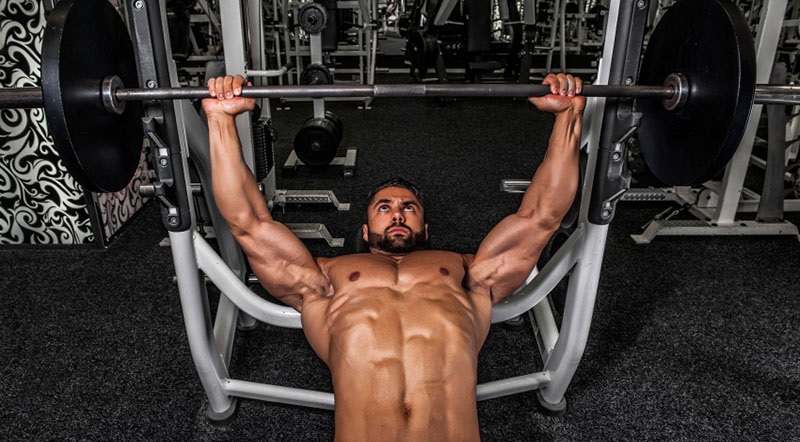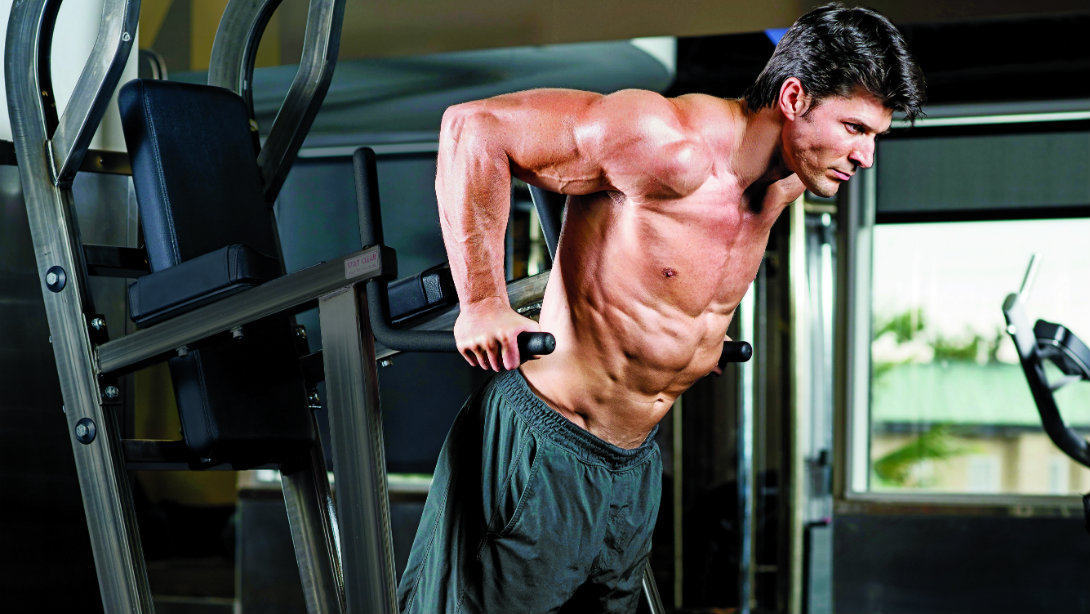Having a good chest, along with being one of the pinnacles of bodybuilding and fitness in general, is difficult to achieve. Symmetry, definition and fullness in your pectoral muscles isn’t achieved by doing 10 pushups a day, it takes a lot of grueling hours in the gym.
Of course, with its status as being one of the necessities for having a great total physique, the topic of exercising the chest is hotly debated. Machines or free weights? Cable or dumbbell flyes?
One of the most divided topics in chest development is the argument between dips and bench press for total chest development. Let’s dive right in and see what makes each exercise tick, and how each can help (or hurt) our workouts.
Bench Press
Ahh yes. Widely regarded as the king of upper-body exercises, measured in lifting competitions and implemented for chest development by nearly every professional and aspiring bodybuilder. The bench press is widely thought of as a measurement of chest strength by novice lifters, but the bench press also recruits the shoulders, triceps and stabilizer muscles from all over your upper and lower body.
One of the most beneficial aspects to the bench press is that it allows the lifter not only to increase volume by number of sets and reps, but by weight. Bench press is an exercise in which weight can be moved up relatively quickly in the beginning stages (until a plateau is reached).
Whether you’re pounding away in a commercial gym or you’ve picked up a nice inexpensive bench press for your own home gym, one of the most popular beginner programs is the 5×5, which utilizes the powerlifting principle of low reps to gain strength to build a good foundation for the novice lifter. The 5×5 program calls for a 5lb increase every workout on the bench press; which, in 2 weeks, is a 15lb increase. This rapid increase in volume that are capable with large, compound movements such as the bench press is great for chest development by continuously increasing the stress on the muscle in terms of volume by weight.
In general, the bench press is a versatile exercise with many variations to change up range of motion and target different areas of the chest. The two most common variations are barbell presses and dumbbell presses, so let’s talk about those two.
Barbell Bench Press
PROS:
From high school football practice to professional powerlifting competitions, the barbell bench press is the most common test of upper body strength. Looking at the barbell bench press through the lens of muscle development, it is certainly the powerhouse that its reputation leads you to believe it is.
Mainly targeting the middle and lower pectoral muscles of the chest, the flat barbell press is a compound movement (meaning recruiting more than one muscle group), that allows for good range of motion and is a simple movement.
The barbell bench press can also be performed at an incline or a decline. The incline barbell bench press recruits more muscle fibers from your upper chest, and the decline bench press recruits more of your lower chest in the movement.
CONS:
With much weight, comes much responsibility. Form and the strength of muscle stabilizers are extraordinarily important when weight goes up in bench press. Improper form and weak stabilizers can lead to injury, and the bench press is one of the most common exercises to receive an injury while performing (mostly due to too much weight and bad form).
Dumbbell Bench Press
PROS:
The debate between Barbell and Dumbbell Bench Press is just as big as the one for Dips and Bench Press. For chest development and physique improvement, the dumbbell bench press can be seen as superior due to the greater range of motion and recruitment of stabilizer muscles to keep each dumbbell still during the pressing motion.
The dumbbell bench press also requires much less setup and you don’t have to mess with plates or calipers or spotters. If a dumbbell press rep is too much to handle, you can simply drop the weights to the side without fear of injury.
CONS:
Of all of the advantages dumbbell bench press presents, it really only has two main drawbacks.
The first drawback would be weight limit. In most gyms, dumbbells don’t usually go past 100lbs. It will take a while to reach that level, but once you do, that’s it.
If you’re not limited by access to appropriately weighted dumbbells, you might be limited by being able to get them into place for the exercise (the second drawback). Most of the injuries that happen with DB bench press happens getting the dumbbells into place or getting them to and from the rack. This is where form is super important – be sure not to use any jerking motions and lift with the appropriate movements.
Also, if you’re working out at home, it’s not very cost-effective to buy dumbbells for every weight you go up, or dumbbell handles and small plates in addition to your barbell and full-size plates. Luckily, nowadays you can pick a nice set of adjustable dumbbells for a pretty reasonable price.
Dips
Dips have somewhat of an elite status among those in the fitness world, and air as something of a “best kept secret”. Chest dips, despite being one of the most effective chest exercises out there, does not make its way into very many beginner programs, and therefore usually goes unnoticed until the fateful day someone stumbles across them and their chest is changed forever.
PROS:
Dips offer a great range of motion, and also a different one. One of the major advantages dips has over bench press for chest development is that it simply recruits the chest more.
In a bench press, your shoulders are recruited exponentially more than in dips. When performing a chest dip, your body moves down, which makes it almost exclusively a chest-recruiting movement, but it still allows your shoulders to stretch at the bottom of the movement. This makes dips a more functional and safe movement.
After you get comfortable on dips, volume can be increased by means of sets and reps, and also by wearing a weight belt that allows you to hang plates from it.
Another big pro of dips is that they can be performed in a variety of situations. A combination pullup/dip station for your home gym won’t cost you more than $200 and can be a staple of your workouts for chest, back and abs. Dips can also be performed anywhere there are parallel bars or a jungle gym.
This level of versatility and accessibility makes it easier to get your chest workout in, even with a busy lifestyle.
CONS:
As with bench press, form is EXTREMELY important to performing dips. Even though this is a bodyweight exercise where you won’t have 300lbs sitting on your chest, repetitive bad form can take a toll on your joints.
Another con of dips is that the movement has a slower learning curve than the bench press. If your gym has an assisted dip machine; use it. It can help you get used to the movement and get you to the point where you can do them without assistance. If you don’t have access to an assisted dip machine, you’ll have to do partial reps from different parts of the range of motion to strengthen yourself to do one full rep – after that it’s all downhill.
So Which Is Better, Dips or Bench Press?
Well, that all depends on what your goals are. If your goal is to build up a massive chest and gain a large amount of measurable strength, bench press is probably your best bet – just make sure to stretch, pay attention to form, and strengthen your stabilizers and rotator cuffs (and have a spotter!). If your goal is to build and shape a nice chest but have more functional strength and reduce your risk of injury, you would lean more towards dips.
With that being said, for total chest development AND functional strength, do both. If you’re supersetting on chest and back day, do bench press first for your first few sets and dips for your second – or maybe alternate each workout between bench press and dips to give your rotator cuffs a rest. Take a look at your goals, evaluate your needs in a chest exercise and get to benching, get to dipping or get to both.



vince gironda had tests done on dips. electromyogram results showed 37 percent more chest activity than the bench press. this man trained some of the greatest body builders in history. check him out, yes.
Terimakasih atas masukanya